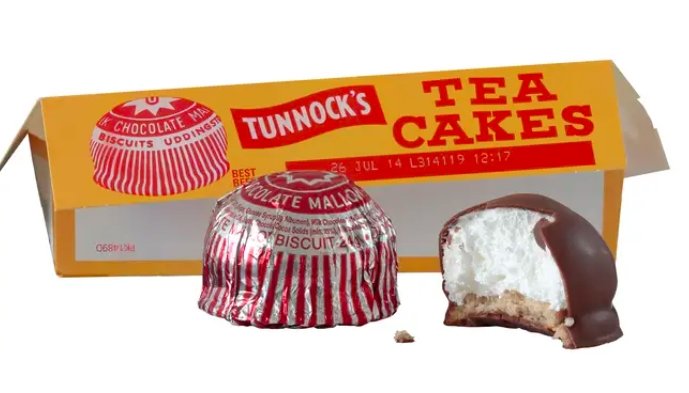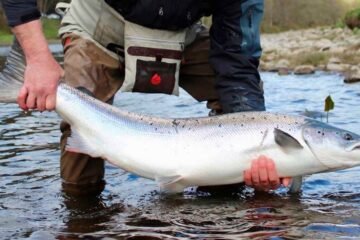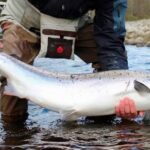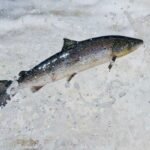In a story that could only come from Scotland — involving chocolate, Cold War bombers, and high-altitude marshmallow mishaps — Tunnock’s teacakes have officially been cleared for flight, nearly 60 years after they were rumored to pose a sticky hazard in the skies.
The Royal Air Force has revisited the curious case of the airborne sweet treat, putting the iconic snack through pressure tests more at home in a fighter jet than a bakery. The results? Tunnock’s teacakes may crack under pressure, but they won’t explode.
Flashback to 1965: A Sticky Situation at 25,000 Feet
Legend has it that sometime in the summer of 1965, a training sortie involving a student pilot and captain ended with marshmallow on the canopy and instruments — the aftermath of an emergency cabin depressurization gone wrong.
The culprit? Two unwrapped Tunnock’s teacakes, resting innocently above the cockpit’s instrument panel.
When cabin pressure dropped suddenly, the marshmallow center expanded, the chocolate coating ruptured, and the teacakes detonated in a gooey mess across the crew and cockpit. Ever since, the story has floated through RAF folklore like a sticky ghost — and according to some, the beloved Scottish confection was quietly grounded from military flights.

A Treat Under Test: RAF Scientists Go Full MythBusters
Enter 2025. The RAF Centre of Aerospace Medicine, located at RAF Henlow in Bedfordshire, decided to put the story to the test — literally — using altitude simulation technology normally reserved for fighter pilots.
Dr. Oliver Bird, an instructor at the centre, led the unusual investigation. Working with BFBS (British Forces Broadcasting Service) journalist Hannah King, the team loaded up several teacakes into an altitude chamber, where the pressure and atmosphere can be precisely manipulated.
The Procedure
-
Ascent to 8,000 feet, climbing at 4,000 feet per minute.
-
Rapid decompression to 25,000 feet in just three seconds.
That’s the kind of pressure drop that scrambles your ears, cracks your chocolate, and — allegedly — causes marshmallow mayhem.
The Results
The teacakes did what any sane chocolate dome would do at near-space altitude:
-
The air inside expanded.
-
The mallow bulged.
-
The chocolate cracked.
But crucially: no explosion. No cockpit-covering eruption. No marshmallow mortars.
As Hannah King put it: “While the mallow escaped from the chocolate casing, they did not appear to explode and cause a risk to in-flight safety.”
Frozen Teacakes? Even Better at Altitude
Another discovery added a twist to the tale: freezing the teacakes beforehand made them far more resistant to pressure changes.
According to Dr. Bird, the chocolate shell becomes significantly less prone to cracking when hardened. His advice to future pilots with a sweet tooth?
“The best advice is that the snacks are kept frozen and in their foil wrappings until pilots are ready to consume them.”
Not exactly regulation, but sage words for the snack-savvy.
Tunnock’s Reacts: “Glad to Serve Supersonic Snackers”
Tunnock’s — the family-run Scottish firm based in Uddingston, just outside Glasgow — responded with a dose of trademark humour.
Sales Director Fergus Loudon was quick to offer perspective on the mid-air mallow scare:
“If we really are talking about the people who fly our supersonic jet fighter bombers, then I’m inclined to think that Tunnock’s Tea Cakes wouldn’t be the highest thing on their list of worries. But I’m glad to hear that they can now enjoy them, like everybody else, with official approval.”
Founded in 1890, Tunnock’s produces millions of the signature teacakes annually — a biscuit base topped with a dome of marshmallow and coated in milk chocolate, all wrapped in gleaming foil. The treat is beloved across Britain and internationally, including by astronauts, schoolchildren, and evidently, bomber crews.
But Was It Ever Really Banned?
Interestingly, despite the legend and the experiment, the RAF insists there was never an official ban.
An RAF spokesperson said no known list of “banned confectionary” exists in official records and noted that the tests were not conducted under formal orders. It seems the tale of the marshmallow mishap has lived mostly in the oral tradition — a culinary cautionary tale passed from pilot to pilot.
But now, thanks to aerospace medicine and a little media curiosity, the RAF can finally put the rumors to rest.
Or, as one former pilot quipped on social media, “Let teacake eaters soar again.”


















